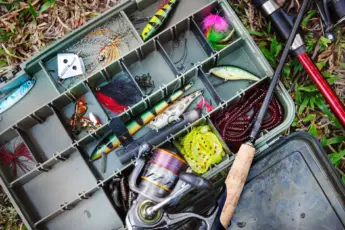A popular saltwater gamefish on the east coast of the United States is the horse eye jack, otherwise known as a bigeye jack or bigeye trevally. The muscular fish are known for drag-pulling battles that put anglers to the test in Georgia, South Carolina, and North Carolina. The horse eye is species that belongs to a family of over 150 variations. Learn what you need to know about the horse, bigeye, trevally, or whatever name you prefer for the fish.
How Do You Identify A Bigeye Jack
The Horse eye is similar in appearance to that of a crevalle jack. The bodies of both species are highly compressed. However, distinct differences are apparent. When comparing horse eye jack vs jack crevalle big eye jacks feature a rounded head while jack crevalles are blunt.
Horse eye fish coloration varies based on the environment. The lower half is silver and darkens to black or gray along the top.
The yellow tail is deeply forked, and the pectoral fins are extended. Lastly, hence the name, the eyes of the fish are enormous.
What Do Horse-eye Jack Eat
The horse eye has a ferocious appetite. Big eye jacks consume shrimp, invertebrates, and both dead and live fish. The fish are aggressive feeders, always searching for the next meal to support their muscular and lean bodies.
How Big Does A Horse-eye Jack Get
The bigeye trevally is moderately sized, considering all of the fish in the family of jacks. Horse eye jack are most frequently caught between five and ten pounds. However, it is not uncommon to catch horse eye jack topping twenty pounds.
What Is The Range Of A Bigeye Jack
Bigeye trevally is common along the eastern shores of the United States. The fish ranges between the Chesapeake Bay and Florida.
As a result of the range, the big eyed jack is a popular game fish because of its fighting capabilities. We can tell you first hand that they are excellent fighters as we have caught numerous horse-eye jack.
Is Horse-Eye Jack Edible
The big eye jack is not considered a quality eating fish. The fillets are dark in color and notorious for a fishy taste despite utilizing proper storage and cooking methods. We advise releasing all that are caught because no horse eye jack edible.
What Is The Habitat Of A Bigeye Trevally
The bigeye jack is distributed in both inshore and offshore waters. Horse eye prefer open waters with minimal turbidity. The fish cruise beaches and offshore reefs.
Small schools of bigeye trevally congregate in bays, channels, and harbors. Anglers are not required to venture well offshore to chase horse eye jacks.
How Do You Catch Horse Eye Jack
Horse eye jack fish are aggressive feeders that will readily strike a wide variety of presentations. We have encountered numerous bigeye jack when targeting mutton snapper. The strike and fight share similar characteristics, only to be surprised when the fish comes alongside. However, the mutton is far superior in taste to the big eye jack.
In regards to gear, light to medium action spinning combinations is ideal. While we don’t have a crystal ball to determine the exact size of the fish we catch, medium-weight rods and reels will do the trick. Remember to check leaderline for abrasion prior to casting to reduce the likelihood of a breakoff during the fight.
Artificial Baits
Artificials are best presented by casting or trolling jigs, spoons, and lures. Keep an eye out for fish, creating a frenzy at the surface as they disperse bait schools while feeding. Constantly troll in the vicinity of the bait to produce more strikes but avoid over tightening the drag causing the line to break when the fish hits the lure.
Live Or Dead Bait
Use it to your advantage when you have the opportunity to throw a cast net and catch live bait. Drift the bait beneath a float or weighted along the bottom. Equally as effective are whole dead fish measuring under four inches in length. Allow the bait to drift slowly to the bottom without lead or sink it to the seabed. In any situation, be prepared for a blazing drag hit.
Go Bigeye Jack Fishing In Your Local Coastal Waters
Despite the inability to eat the fish, the fight is worth chasing horse eye jack. The fish are located both inshore and offshore. Therefore, you will avoid long run times to find bigeye trevally. Always remember to obtain a saltwater fishing license. Lastly, set your drags before the first cast to avoid learning the hard way by breaking the line and losing the fish.





